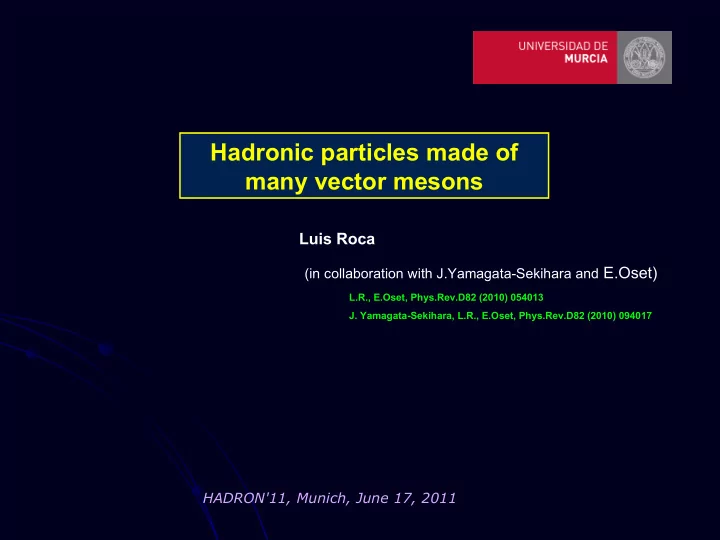

Hadronic particles made of many vector mesons Luis Roca (in collaboration with J.Yamagata-Sekihara and E.Oset) L.R., E.Oset, Phys.Rev.D82 (2010) 054013 J. Yamagata-Sekihara, L.R., E.Oset, Phys.Rev.D82 (2010) 094017 HADRON'11, Munich, June 17, 2011
Introduction ρρ interaction in isospin 0 and spin 2 is very strong (UChPT) R.Molina, D.Nicmorus, E.Oset, PRD78,114018(2008) f 2 (1270) , J PC =2 ++ f 2 (1270) is a molecule of two ρ (770) Binding energy very strong ~140 MeV/ ρ = ¡20% of the ρ mass, only with two particles! Is it possible to obain states with larger number of ρ (770) mesons? , , , etc
What about other vector mesons? K*(892) K* ρ interaction in isospin 0 and spin 2 is also very strong K* 2 (1430) is a molecule of K* ρ L.Geng, E.Oset, PRD79,074009(2009) , , , etc ?
R.Molina, D.Nicmorus, E.Oset, PRD78,114018(2008) Vector-vector interaction L.Geng, E.Oset, PRD79,074009(2009) Interaction kernel provided by the hidden gauge symmetry Lagrangians M. Bando et al.’1985,’1988
contact term dominant t,u channel s channel t,u channel V exchange V V (s channel basically p-wave small) provides ππ decay box T Kernel of V G = Bethe-Salpeter strong attraction
ρρ I=0, S=2 f 2 (1270) , J PC =2 ++ Cutoff set to get the peak at the f 2 (1270) mass And that’s all the freedom for the rest of the work ! f 2 (1270) is a molecule of two ρ (770) Is it possible to obain states with larger number of ρ (770) mesons? ~140 MeV/ ρ = ¡20% of the ρ mass, only with two particles! Binding energy very strong , , , etc
, ? ? , , etc Possible candidates for multi- ρ (770) states in the PDG:
Interaction of several ρ (770) Three ρ ’s: Since two ρ tend to clusterize, we study the interaction of one ρ with the other two ρ clusterized building up a f 2 (1270) Fixed center approximation to Faddeev equations: (similar to kaon-deuteron, Kamalov, Oset, Ramos ‘01 )
Single scattering: S-matrix: ρρ unitarized amplitude
Single scattering: S-matrix: ρρ unitarized amplitude Double scattering:
Single scattering: S-matrix: ρρ unitarized amplitude Double scattering: f 2 (1270) form factor Same cutoff as in the scattering of two particles L.Geng, E.Oset, PRD79,074009(2009)
Single scattering: S-matrix: ρρ unitarized amplitude Double scattering: Full scattering amplitude:
Larger number of ρ mesons: 4 ρ ’s (f 4 ): interaction of two f 2 5 ρ ’s ( ρ 5 ): interaction of ρ -f 4 6 ρ ’s (f 6 ): interaction of f 2 -f 4
Results (dotted: only single scattering)
(masses: from position of the maximum)
Inclusion of K*(892) Possible candidates for K* multi- ρ states in the PDG: K* 5 (2380) K* 6 ???
(masses: from position of the maximum)
Summary - ρρ and K * ρ interaction in I=0, S=2 is very strong (kernel: VV interaction from HGS) f 2 (1270) and K * 2 (1430) dynamically generated (UChPT) - M any-particle interaction from fixed center Faddeev equations - Prominent shapes for the multi-body scattering amplitudes - Maxima in very good agreement with the masses of ρ 3 (1690), f 4 (2050), ρ 5 (2350) and f 6 (2510) dynamically generated from multiple ρ interaction (3, 4, 5 and 6 ρ ’s respectively) - Inclusion of K*: K* 3 (1430), K * 4 (2045), K* 5 (2380) and K * 6 (2510) dynamically generated from K *-multiple ρ interaction
EXTRA
UChPT (unitary extensions of chiral perturbation theory) ChPT very sucessful to describe a large amount of phenomenology at low energies Problems (limitations) of ChPT: - The number of parameters increases a lot with the order of the expansion - The energy range of applicability is restricted to low energies Typically till the energies where the first resonances resonances appear A resonance implies a pole pole, which a perturbative expansion can never produce ChPT cannot be applied to the region of intermediate energies where the hadronic spectrum is very rich
Basic idea of UChPT: Oller, Oset, Dobado, Pelaez, Meissner, Kaiser, Weise, Ramos, Vicente-Vacas, Nieves, Ruiz-Arriola, Lutz,... Input: lowest order chiral Lagrangian Extended range of + implementation of unitarity unitarity in coupled channels applicability of ChPT + exploitation of analytic properties to higher energies
Basic idea of UChPT: Oller, Oset, Dobado, Pelaez, Meissner, Kaiser, Weise, Ramos, Vicente-Vacas, Nieves, Ruiz-Arriola, Lutz,... Input: lowest order chiral Lagrangian Extended range of + implementation of unitarity unitarity in coupled channels applicability of ChPT + exploitation of analytic properties to higher energies Unitarity of the S-matrix implies: G T V V T = (Bethe-Salpeter eq.) = V G V V V G V V G The kernel of the BS equation, V , is the lowest order ChPT Lagrangian Effectively, one is summing this infinite series of diagrams
Example: MM in s-wave Prominent shapes for the resonances Many resonances appear without including them explicitly “dynamically generated” resonances Important: UChPT not only gives spectroscopy (masses and widths) but the shape of the scattering amplitude out of the resonance position
Recommend
More recommend